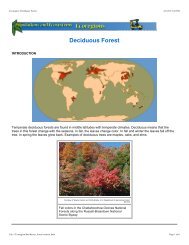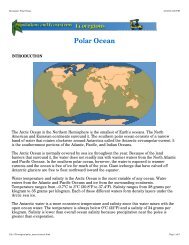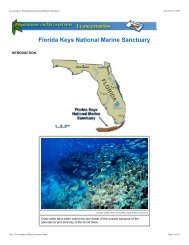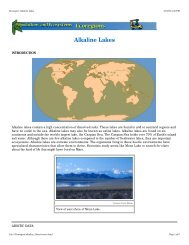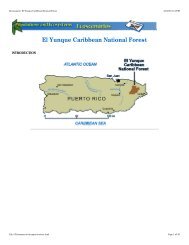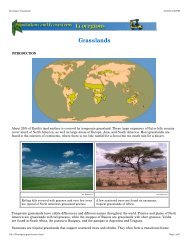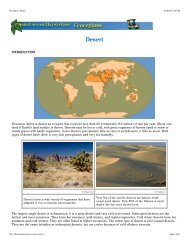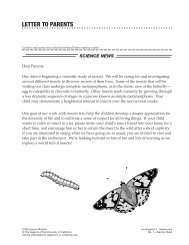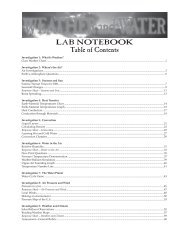Ecoscenarios Combined - FOSSweb
Ecoscenarios Combined - FOSSweb
Ecoscenarios Combined - FOSSweb
Create successful ePaper yourself
Turn your PDF publications into a flip-book with our unique Google optimized e-Paper software.
Ecoscenario: Florida Keys National Marine Sanctuary<br />
4/16/03 3:17 PM<br />
Off the tip of Florida is an archipelago of 1700 islands called the Florida Keys. This island chain is a coral reef that<br />
begins at the tip of Florida, just south of Key Biscayne and curves southwest for 202 kilometers (126 miles). It ends<br />
145 kilometers (90 miles) north of Cuba.<br />
Many of the islands are too small for people to live on. Surrounding the keys is Florida Keys National Marine<br />
Sanctuary. This marine sanctuary covers 9600 square kilometers (2800 square nautical miles). It is the closest<br />
federally protected coral reef to the continental United States. The reefs of Florida Keys National Marine Sanctuary<br />
form the only living coral barrier reef in North America. It is the third largest system of coral reefs in the world. Only<br />
the Great Barrier Reef of Australia and barrier reefs off Belize are larger. The warm clear water ranges in depth from<br />
0.6 to 610 meters (2 to 2000 feet) with an average of 15.25 meters (50 feet).<br />
The ocean currents that pass through the Florida Keys connect with the Gulf Stream and major shipping routes<br />
along the Atlantic seaboard. The reefs are littered with ships washed onto the shallow reefs by hurricanes, sudden<br />
tropical storms, or navigation errors. Ships grounded on reefs break apart and are scattered by waves. Since the<br />
1500s, over 800 wrecks have been recorded. In the early 1900s most of the wrecks were salvaged, and today little<br />
evidence remains.<br />
In 1957, a group of scientists and conservationists held a meeting in the Florida Everglades to discuss the state of<br />
the keys. They were worried that the crowds of visitors often damaged the coral and were destroying the reefs. This<br />
meeting resulted in the founding of the world's first underwater park, the John Pennekamp Coral Reef State Park, in<br />
1960.<br />
Courtesy of Florida Keys National Marine Sanctuary<br />
Map of the Florida Keys shows several areas of management, including the Florida Keys<br />
National Marine Sanctuary, wildlife refuges, two national parks, and state managed areas.<br />
Problems like pollution and overharvesting of sea life also threatened this ecosystem. The coral reefs could be<br />
better managed and monitored if they were included within a state or national refuge or park. The creation of the<br />
National Marine Sanctuary System in 1972 helped protect the special ecological, historical, and recreational<br />
resources of unique ocean habitats. Two areas of the Florida Keys were designated as sanctuaries, one in 1975<br />
and another in 1981. These areas, together with the waters surrounding the entire Florida Keys, became Florida<br />
file:///Ecoscenario/flakeys/content.html<br />
Page 2 of 18



